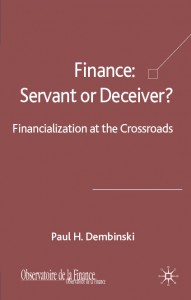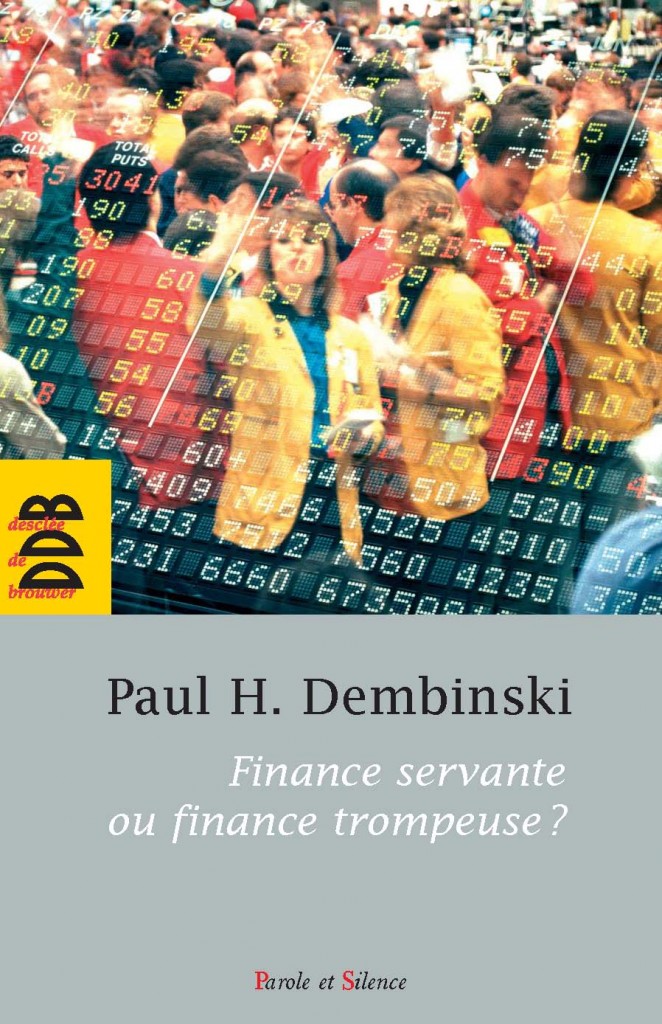Finance: Servant or Deceiver? Financialisation at the Crossroad, Prof. Paul H. Dembinski, Palgrave Macmillan, 2009, 179 pages.

The work of the Observatoire de la Finance over the past ten years has shown that the continuing spread of financial logic through society is the result of a converging set of factors: the development of technology and, more generally, of wealth-creating capacity, a growing dread of risk and the unforeseen as living standards increase, finance’s theoretically based claim to guarantee the West a peaceful future, the challenges and aspirations of countries in the South with regard to economic and social development, and so on.
In the course of the Observatoire’s research it has become clear that the psychological, philosophical and moral dimensions of finance are as important to a proper understanding of it as are its economic, technical and institutional aspects. It is these avenues that the Observatoire has explored over the past decade.
The result today is an epistemologically coherent conceptual framework that has been used to help draw up a systemic diagnosis. The diagnosis, which is the subject of this book, reveals that behind the conspicuous expansion of finance a systemic transformation, referred to here as ‘financialization’, is in fact taking place.
Summary
INTRODUCTION
Background
Good timing
Theoretical background
How financialization is changing society
Structure of the report
PART I: THE FINANCIAL ICEBERG
Chapter 1.1 THE HISTORICAL DEVELOPMENT OF FINANCE
The euphoric years
Money: from servant to master
ICT euphoria
The break-up of money
Chapter 1.2 PLAYERS AND INSTITUTIONS
Markets as trust-building mechanisms
Mega-players
Custodians of the market temple
Public deficits and how they are financed
Chapter 1.3 THE FINANCIAL WORLD VIEW
The efficiency ethos
Risk and return: a neat paradigm
Risk – fear of risk – a risk-free future
From interest to greed: unbridled passion
PART II: A NEW PATTERN
Chapter 2.1 FINANCIAL RELATIONSHIPS AND FINANCIAL TRANSACTIONS
Financial relationships
From financial relationships to financial transactions
Financial transactions
Chapter 2.2 THE SPREAD OF TRANSACTIONS
The institutional process
Financial markets as sounding boards
Finance as intermediary
Relationships and transactions: statistical orders of magnitude
Finance and the rest of the economy
Chapter 2.3 VERY LARGE CORPORATIONS: THE VEHICLES OF FINANCIALIZATION
Very Large Corporations (VLCs)
A global marketing economy
Enterprises’ value: new forms of capital
Shareholder value: the mantra of the new foremen
ROE rules
Procedures as a vehicle for efficiency
Chapter 2.4 FINANCIALIZATION OF THE ECONOMIC FABRIC
VLCs’ subcontractors
SMEs: private equity on the prowl
Chapter 2.5 TYING CUSTOMERS TO BUSINESSES
Planned obsolescence
‘Personalized’ customer relations
Dissolving products into services
The alienation of the anaesthetized consumer
Chapter 2.6 OTHER ASPECTS OF FINANCIALIZATION
The age of anticipation: banks and their customers
Humanity in the grip of financialization
Finance: a metaphysical response
Chapter 2.7 IMPLICATIONS OF THE NEW PATTERN
PART III : FINANCE – WHAT KIND OF SOCIETY DO WE WANT?
Chapter 3.1 LIMITS INHERENT IN THE PROCESS ITSELF
The spectre of sterility
Complexity
Concentration of economic power
Chapter 3.2 LIMITS INHERENT IN HUMAN NATURE
Transactions: beyond conflicts of interest
Ethical alienation
A sense of helplessness
Chapter 3.3 WHAT IS TO BE DONE?
Challenge financial ethics
Encourage long-term relationships
Change the system of remuneration
Revisit financial process
Finance servante ou finance trompeuse? Prof. Paul H. Dembinski, Paris, Desclée de Brouwer, 2008, 200 pages.

Les travaux réalisés durant les dix dernières années dans la mouvance de l’Observatoire de la Finance ont progressivement montré que la pénétration de plus en plus profonde de la logique financière dans la société résultait du jeu convergent d’un faisceau de facteurs : le développement de la technologie et, plus généralement, celui des capacités de création de richesse, la hantise croissante du risque et de l’imprévu croissante avec l’augmentation du niveau de vie, la prétention théoriquement fondée de la finance à garantir à l’Occident un avenir paisible, les défis et aspirations des pays du Sud en matière de développement économique et social, etc.
Ainsi, au fur et à mesure de ces recherches, les dimensions psychologique, philosophique et morale de la finance sont apparues comme étant aussi importantes à sa compréhension que ses aspects économiques, techniques et institutionnels. Ce sont les pistes que les travaux de l’Observatoire de la Finance ont exploré pendant les dix années passées.
Ces efforts aboutissent aujourd’hui à un cadre conceptuel cohérent du point de vue épistémologique qui a été mis à contribution pour permettre d’articuler un diagnostic de portée systémique. En vertu de ce diagnostic, qui est l’objet du présent ouvrage, derrière l’apparente montée en puissance de la finance se cache en fait une transformation systémique. Cette transformation est qualifiée ici de «financiarisation».
Table des matières
INTRODUCTION
Mise en perspective
Un contexte propice
Un peu d’épistémologie
La financiarisation – une transformation systémique
La structure du rapport
PARTIE I : L’ICEBERG DE LA FINANCE
1.1 LE CONTEXTE HISTORIQUE DU DÉVELOPPEMENT DE LA FINANCE
Les « années euphoriques »
De la monnaie servante à la monnaie maîtresse
L’informatique : l’euphorie technologique
L’éclatement de la monnaie
1.2 LES ACTEURS ET LES INSTITUTIONS
Le marché – une mécanique pour inspirer la confiance
Les méga-acteurs
Les gardiens du temple du marché
Les déficits publics et leur mode de financement
1.3 LA FINANCE DANS LA WELTANSCHAUUNG
Ethos de l’efficacité
Risque et rendement : un paradigme séduisant
Le risque, la peur du risque, un avenir sans risque
De l’intérêt à la cupidité : la passion déchaînée
PARTIE II : L’AFFIRMATION D’UNE COHÉRENCE
2.1 LA RELATION ET LA TRANSACTION FINANCIÈRES
Les relations de financement
De la relation à la transaction financière
La transaction financière
2.2 VERS LA PRÉÉMINENCE DE LA TRANSACTION
La dynamique institutionnelle
Le marché financier – caisse de résonance
Vers une finance d’intermédiation pure
Relation – transaction : ordres de grandeur statistiques
La finance et le reste de l’économie
2.3 LES TRÈS GRANDES ENTREPRISES: LE RELAIS DE LA FINANCIARISATION
Les très grandes entreprises (TGE)
Une économie de marketing global
La valeur des entreprises : les nouvelles formes du capital
Shareholder value – la religion des nouveaux contremaîtres
Le ROE est roi
La procédure – le relais indispensable de l’efficacité
2.4 LA FINANCIARISATION DU TISSU ÉCONOMIQUE
Les fournisseurs des TGE
Les PME – le « private equity » à l’affût
2.5 LE CLIENT ARRIMÉ À L’ENTREPRISE
Maîtriser la durée de vie du produit
Personnaliser le rapport au client
Dissoudre le produit dans le service
Aliénation du consommateur lénifié
2.6 LES AUTRES ASPECTS DE LA FINANCIARISATION
Le règne de l’anticipation – les banques et leurs clients
L’homme dans l’étreinte de la financiarisation
La finance – une réponse métaphysique
2.7 QUELLE COHÉRENCE?
PARTIE III : FINANCE SERVANTE OU FINANCE TROMPEUSE?
3.1 LIMITES ENDOGÈNES
Le spectre de la stérilité
La complexité
La concentration du pouvoir économique
3.2 LES LIMITES EXTERNES ANTHROPOLOGIQUES
La transaction – au-delà du conflit d’intérêts
L’aliénation éthique
Le sentiment d’impuissance
3.3 QUE FAIRE ?
L’éthique de la finance en question
Privilégier la relation et la durée
Modifier les rémunérations
Démanteler l’épargne financière


